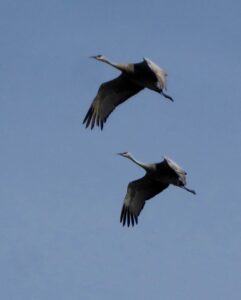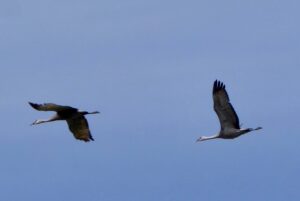 There may be a lot of good ways to spend time with a friend, but placing yourself under a skyful of sandhill cranes has to be pretty high on the list. We went to nearby Sauvie Island hoping for cranes and we heard them almost right away. Which means they were within a mile. Or three. Cranes is loud.
There may be a lot of good ways to spend time with a friend, but placing yourself under a skyful of sandhill cranes has to be pretty high on the list. We went to nearby Sauvie Island hoping for cranes and we heard them almost right away. Which means they were within a mile. Or three. Cranes is loud.
Sandhill cranes are named after the Sandhills in Nebraska, close by the Platte River, where the birds hold their premier convention and jubilee. Their fancy name is Antigone canadensis. Antigone was the name of Oedipus’s daughter and it’s best not to speculate who her mother was. The genus name Antigone, it says here, was “erected by the German naturalist Ludwig Reichenbach” in 1853. Up until now, I had no idea you could make a whole genus with one erection. Way to go, Lud! The species name “canadensis” is Latin for “from Canada.” Them Romans seem like mighty advanced geographers, but that’s the nature of empire.
Sandhill cranes are ridiculously cool. Their wingspan is about the same as one Dave flipped sideways, on average, and that’s not trivial. They have red hats. They lope through the air with their streamer legs behind them until they decide to check out the menu on the ground, and then they let down their landing gear and drift and cant and tilt and wobble like autumn leaves until they touch down and fold up neat and tidy. Best of all, they do it while sounding like cranes. If that doesn’t scour the crud of daily tedium right out of your system and replace it with holy wonder, you need your soul taken in for an adjustment.
 Sandhill cranes sound better than almost anything else in the world because their windpipes are very long, even longer than they are. Their tracheae are all looped up inside them to fit, and the whole contraption rattles and hoots and vibrates like a trombone having its way with a pan flute.
Sandhill cranes sound better than almost anything else in the world because their windpipes are very long, even longer than they are. Their tracheae are all looped up inside them to fit, and the whole contraption rattles and hoots and vibrates like a trombone having its way with a pan flute.
We saw flocks of sandhills and flocks of geese and flocks of pelicans and one very colorful flock of young birders from the local Feminist Bird Club of Portland. Each had a black mask but other plumage ranged right through the rainbow. Such sightings are no longer rare but they’re always a thrill and we all hope their numbers are on the rise.
So we did score hundreds of sandhills and it is a credit both to the birds and to my friend that she was every bit as thrilled as I was, even though she has been to Nebraska where they accumulate in platoons. You can’t get tired of cranes, is the point.
I was with my sister Margaret the first time I saw them. Under that ecstatic, clattering sky, heaven was redundant. We watched them sift down, a hundred of them, and stand in the field. Margaret managed to drag her oxygen tank and gigantic camera in their direction for a closer look, but no matter how many steps we took, they remained the same distance away, as though they were melting into the future. And I hope they were.
 The thing about Margaret, and you can ask anybody: Margaret had a rough go of it in life but she was unexcelled at pulling joy into herself at every opportunity, and letting it right back out again. And joy that traveled through Margaret had a way of amplifying everyone else’s. Like sending ordinary air through a crane trachea.
The thing about Margaret, and you can ask anybody: Margaret had a rough go of it in life but she was unexcelled at pulling joy into herself at every opportunity, and letting it right back out again. And joy that traveled through Margaret had a way of amplifying everyone else’s. Like sending ordinary air through a crane trachea.
Back home in the city, sitting on the patio with a beer and thinking about the day, I watched a red-tailed hawk doing a tight circle straight up high, and watched our usual yard birds glancing up and doing a little basic arithmetic, and watched a rufous hummingbird and an Anna’s hummingbird chase each other until they locked bills, and they dervished in the air like a fidget spinner right above my head. Yes, they did. Birds, man. We might think we have better things to do than to watch, and listen, and learn, but we don’t.
I was hoping that when you described the sound that you would leave a link to it, and there it is! What a beautiful, haunting sound! I can only imagine a hundred of them all making that sound. Wow!
See if you can work your way toward standing under them.
Does standing under them lead to understanding them?
Hi Murr, Thank you for this wonderful morsel of a sound bite sent through the ether. I’ve never clapped eyes on a Sandhill Crane, but I would love to see and hear one. My partner has seen a Sandhill Crane here in Orkney, Scotland and reminds me of this fact frequently. Sigh.
My family always said “clapped eyes on” and so your comment gave me a thrill. I wonder where it came from. Pogo, maybe?
Hadn’t heard of Pogo, so spent breakfast time reading about Walt Kelly. Thank you again!
I remember reading Pogo in the Sunday comics when I was little. I still remember the panel with their most famous line: “We have seen the enemy and they are us.”
Almost! “We have seen the enemy and he is us.”
When I was a very little kiddo I read a Pogo strip in the Sunday paper that had the song of the Cheerful Charlies club, led by Albert. Still remember every word, for some reason. And of course there’s “Deck Us All With Boston Charlie,” a couple of versions. And “Songs of the Pogo”: “As Maine go o so Pogo go Key Largo…”
Walla Walla Wash and Kalamazoo!
This evokes one of my favorite books of all time — The Yearling. Penny and Jody watch the whooping cranes dancing.
https://englishliterature.net/marjorie-kinnan-rawlings/the-yearling#chapter_10
Wow, it’s been a while since I thought of The Yearling.
I saw two sandhill cranes in Florida, as my non-birder friend drove right on past. Some people need to get their priorities together.
Jeeze! I bet your friend would’ve paid attention if it were the birds’ distant ancestor — the dinosaur!
All the birds have that ancestor–and people still don’t pay attention.
Last time I said that my 8-year old granddaughter corrected me, declaring that their ancestors were the pterosaurs. It will always be hard to keep up with taxonomic revisions, though I should know by now. After all, by the time I was in high school the Latin name for Poison Ivy had already been changed ten times.
I read somewhere that the closest living descendant of the Tyrannosaurus Rex is the chicken. Maybe those tiny little arms were actually incipient wings? And had feathers?
Hmm. Birds in general descend from the theropods, and some flying dinosaurs are thought to have descended from birds…those danged taxonomists change everything more often than they change their shorts, so I’ll have to read up.
” Under that ecstatic, clattering sky, heaven was redundant. ” So good, Murr. When I lived in Texas, we were on the flyway for the cranes, and the sound would bring me out of the house to watch the giant ‘v”s . Our dog would race circles and bark non-stop when he heard them. He could never put together that they were in the sky. He was certain that they were something to be guarded against. Wonderful memory.
I would think you had a good shot at some of them being whooping cranes too!
I deluded myself into thinking I saw a white one amongst the ‘v’s, but I was deluded.
You must must must go to the Rowe Audubon Sanctuary in Nebraska to see the sandhill Spring migration. If you do I can meet you there. It’s a day’s drive from Oklahoma. I was at our nearby refuge one day and I heard a flock way in the distance. Could barely see them. They don’t hang around but it was magical. Also, if you do a nature book like you did this post you’d be a bestseller.
Hon, I HAVE written such a book. I am having the devil of a time getting it published. Throwing a lot of spaghetti at the wall, here. I stand by my book though.
Don’t Give Up! We need that book-
The looped trachea of the crane and the remarkable sound it makes brings to mind the Renaissance instrument, the tartold, a strange double reed thing with a ‘bore formed from cylindrical tubing bent into a spiral’ inside a dragon body.
My goodness, which end of the dragon do you blow into?
Dear God I do love your way with words!! You make the world brighter. Some of Margaret has rubbed off on you.
Nicest thing anyone could say to me.
I’ll second that!
That’s a pretty sound and if I ever hear it in the skies here I’ll know what it is, then I’ll hope it finds its way home again, because it doesn’t belong in Australia.
I read here you have two kinds of cranes in Australia. Try to put yourself under some!
Well, I was about to credit your sister with much the same. So you’ve been well rubbed today.
River…you’re too far south for our cranes (Brolga). But they are here, waaay up North.
There you go. There’s another one too. Don’t know where they are, or where you are.
Murr, this was so wonderful, all of it: the evocative crane calls, your unique way with words, loving memories of your dear sister. “…they dervished in the air like a fidget spinner…” “…and then they let down their landing gear and drift and cant and tilt and wobble like autumn leaves until they touch down…” My own crane memories came flooding in. Yes, joy. Write on, sister!!!
Cranes are inspiring.
When we lived in the Okanagan Valley a migrating flock of Sandhill cranes flew right overhead one evening, so close you could see the red crests on top of their heads. Heartstopping music. I can’t think of it even now without an accelerating heartbeat. I swear Murr, any editor can pink-slip writing like this is an unschooled imbecile!! I just can’t fathom it!
You’re very kind. You should see the list of my unanswered queries. It’s not like I’m not trying.
Before they get to Nebraska, the cranes take a flight break near Willcox, Arizona. Several years ago I drove an hour and a half from Tucson and sat under them and beside them. Holy, holy!
Worth the trip!
Wow.Thank you!
Really enjoyed this.
Ooooo! I loved the sound bite of the cranes! Didn’t we hear loons-on-the-lake when the bunch of us were in the Adirondacks, years ago? I thought the cranes had the same magical sound.
And, how nice to see a picture of Margaret again!